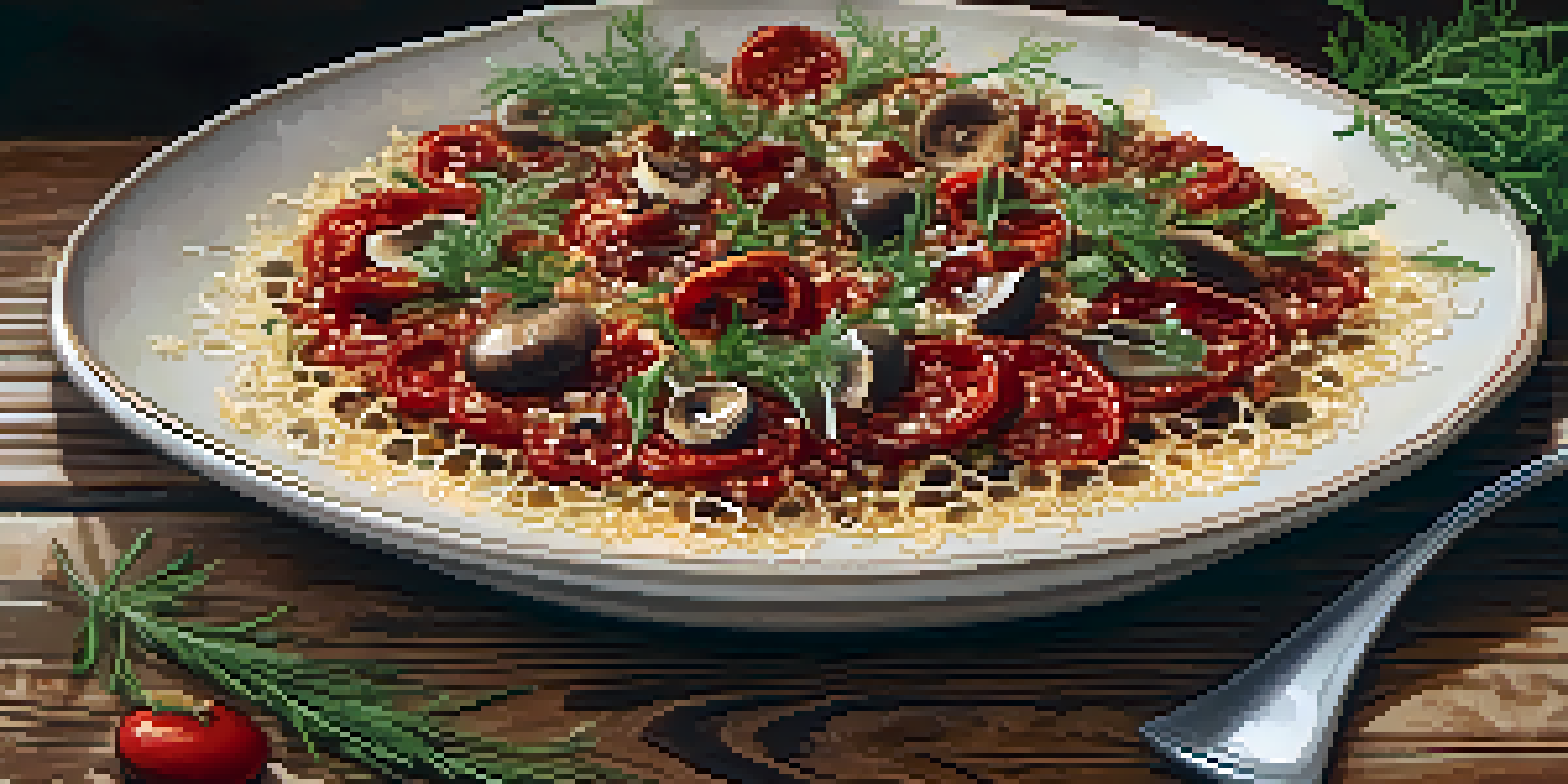Exploring Umami: Techniques to Enhance Flavor Profiles

Understanding Umami: The Fifth Taste
Umami, often referred to as the fifth taste, is a savory flavor that enhances the overall taste experience. Unlike sweet, sour, bitter, and salty, umami is unique because it comes from amino acids, particularly glutamate. It’s commonly found in foods like tomatoes, mushrooms, and aged cheeses, each contributing depth to dishes.
Umami is the taste that brings out the best in every dish.
Think of umami as the secret ingredient that can transform your cooking. It acts like a flavor booster, enriching the taste of your meals without overwhelming them. When you understand umami, you can create more balanced and satisfying dishes, appealing to the taste buds of anyone at your table.
Incorporating umami into your cooking doesn't have to be complicated. Simple adjustments, like adding a sprinkle of Parmesan or a dash of soy sauce, can elevate your dish's flavor profile. By recognizing and utilizing umami, you can enhance the enjoyment of your culinary creations.
Identifying Umami-Rich Ingredients
To harness the power of umami, you first need to know where to find it. Ingredients such as mushrooms, miso, soy sauce, and ripe tomatoes are packed with umami flavor. Even common items like meat and fish contain natural glutamates, making them excellent choices for umami-rich dishes.

For example, consider the effect of using sun-dried tomatoes instead of fresh ones. The drying process concentrates their flavor, intensifying their umami qualities. Similarly, adding a touch of fish sauce to a stir-fry can create a depth of flavor that brings the dish to life.
Umami Enhances Flavor Depth
Umami, the fifth taste, enriches dishes by adding a savory depth that elevates the overall flavor experience.
Experimenting with these ingredients can open up a world of flavor possibilities in your cooking. By incorporating a variety of umami-rich components, you can create dishes that are not only delicious but also memorable, leaving your guests wanting more.
Cooking Techniques to Enhance Umami
Certain cooking techniques can significantly enhance the umami flavor in your dishes. For instance, roasting vegetables caramelizes their natural sugars and brings out their savory notes, creating a rich taste. Similarly, braising meats allows them to absorb flavors and become tender, enhancing their umami profile.
The secret to great cooking is understanding the balance of flavors, and umami is the key to achieving that.
Another great technique is fermentation, which transforms ingredients and heightens their umami characteristics. Think kimchi or miso—these fermented delights are bursting with umami and can be added to various dishes for an extra flavor kick. By embracing these methods, you can elevate your meals to new culinary heights.
Don’t underestimate the power of layering flavors, either. Combining different cooking techniques and umami-rich ingredients can create a complex flavor profile that keeps your taste buds engaged. With a bit of creativity, you can craft dishes that are both satisfying and sophisticated.
Balancing Umami with Other Flavors
While umami adds depth to your dishes, balance is key in cooking. Too much umami can overpower other flavors, so it's essential to find the right mix. Pairing umami with acidity, like a squeeze of lemon or a splash of vinegar, can create a harmonious flavor balance.
Consider a classic example: a tomato sauce. The natural umami from tomatoes pairs beautifully with the acidity of wine or vinegar, resulting in a sauce that is rich and vibrant. This balance of flavors is what makes a dish truly delicious.
Key Umami Ingredients to Use
Incorporating ingredients like mushrooms, miso, and ripe tomatoes can significantly boost the umami profile of your meals.
When experimenting with flavors, taste as you go. Adjusting ingredients based on flavor profiles will help you achieve a well-rounded dish. Remember, cooking is as much about intuition as it is about technique, and finding that perfect balance is what makes a meal memorable.
Umami in Global Cuisines
Umami isn't just a culinary trend; it's a staple in many global cuisines. For instance, Japanese cuisine often celebrates umami through ingredients like dashi, a broth made from kelp and bonito flakes. This umami-rich base enhances countless dishes, showcasing how integral umami is to the flavor profiles of various cultures.
Italian cuisine also embraces umami through ingredients like Parmigiano-Reggiano cheese and sundried tomatoes, which add that savory punch to pasta and risottos. Similarly, Korean cuisine uses fermented ingredients like gochujang and doenjang, both of which are loaded with umami, to create depth in their dishes.
Exploring these diverse cuisines can inspire your own cooking. By incorporating umami elements from around the world, you can create exciting fusion dishes that reflect your personal taste while celebrating global flavors.
Umami-Building Seasonings and Condiments
Seasonings and condiments are fantastic tools for enhancing umami in your cooking. Products like Worcestershire sauce, soy sauce, and fish sauce are packed with umami and can easily be added to a variety of dishes. A few drops can transform a simple recipe into a flavor powerhouse.
Herbs and spices can also play a role in building umami. For instance, smoked paprika or thyme can complement umami-rich ingredients and add an extra layer of flavor. Experimenting with different seasonings will help you discover unique combinations that resonate with your palate.
Balancing Umami with Other Flavors
Achieving the right balance of umami with other tastes, such as acidity, is crucial for creating delicious and memorable dishes.
Don’t forget about the power of stocks and broths! Using homemade or high-quality store-bought stocks as a base for soups and stews can significantly boost the umami factor. By choosing the right seasonings and condiments, you can personalize your dishes and enhance their overall flavor profile.
The Science Behind Umami Flavor
Understanding the science behind umami can deepen your appreciation for this unique taste. Umami is recognized by specific receptors on our taste buds, particularly those that respond to amino acids like glutamate. This physiological response explains why umami-rich foods can evoke such strong cravings.
Research has shown that umami can enhance the perception of other flavors, making food taste more delicious overall. This is why chefs often focus on umami when crafting dishes, as it can elevate the eating experience and leave a lasting impression.

By grasping the science of umami, you become more than just a cook—you become a flavor artist. This knowledge empowers you to create balanced, flavorful dishes that excite the palate and keep diners coming back for more.